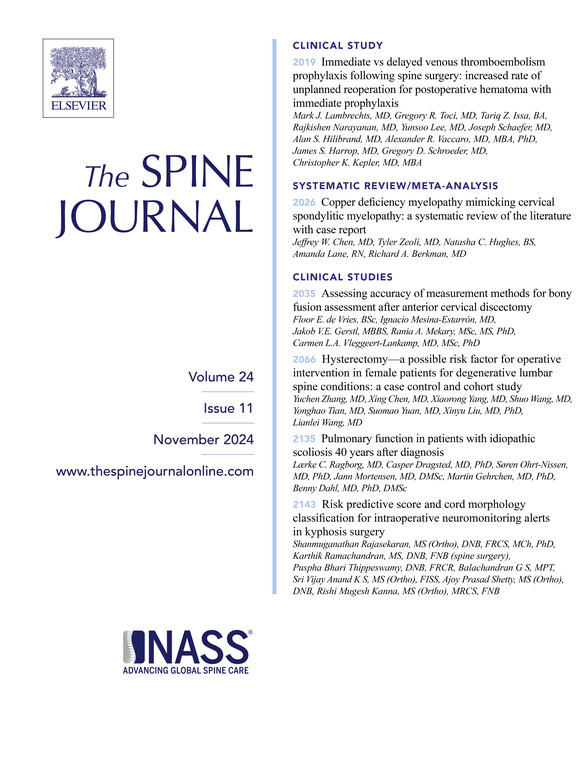根据骨骼的生物力学特性诊断脊柱假关节。
IF 4.9
1区 医学
Q1 CLINICAL NEUROLOGY
引用次数: 0
摘要
背景情况:颈椎前路椎间盘切除融合术(ACDF)后融合失败可能导致症状性假关节。传统诊断方法包括通过计算机断层扫描检测桥接骨和/或通过屈伸X光片评估节段运动是否超过特定阈值;然而,目前还没有经过充分验证的诊断测试。我们提出了一种合理的生物力学方法,以实现对假性关节病的可靠诊断测试。目的:开发并测试一种基于生物力学的假性关节病诊断方法:研究设计:文献综述、理论发展、重新分析之前发表的一项以手术探查为黄金标准的研究,并对汇总研究进行回顾性分析,以了解融合时间:采用全自动方法测量椎间盘间隙应变(椎间盘间隙高度变化除以初始高度)。测量误差结合已报道的骨小梁破坏应变,提出了诊断 ACDF 后假关节的应变阈值。我们重新分析了之前报道的无症状志愿者的屈伸X光片,以评估在未进行融合手术的情况下,屈伸X光片是否能对运动节段提供足够的应力,从而进行可靠的基于应变的融合评估。通过重新分析之前报道过的、术中也可进行融合评估的 ACDF 术后屈伸X光片,评估了基于应变和旋转的假关节诊断的敏感性和特异性。最后,我们使用1,369名患者的9,869张ACDF术后6周至84个月的屈伸X光片评估了应变随时间的变化:根据X光片自动测量椎间盘间隙应变的估计误差约为3%,而报告的桥接骨失败应变小于2.5%。在此基础上,我们提出了假关节诊断的应变阈值为 5%。对一项有术中融合评估的研究进行的重新分析显示,基于应变的假关节诊断灵敏度为67%,特异度为82%,与基于旋转的诊断相当。通过分析 ACDF 术后的屈伸X光片发现,在长达 24 个月的时间里,应变迅速减少,随后在长达 84 个月的时间里,应变减少速度放缓。当旋转角度小于 2 度时,应变诊断与旋转诊断的差异约占 14%:我们提出了根据骨的破坏应变、测量误差和回顾性数据对假性关节炎进行标准化诊断的步骤。这些步骤包括获得高质量的屈伸研究、应用建议的诊断阈值,以及在运动接近阈值时使用图像稳定技术进行确诊。准确诊断的同时尽量减少辐射暴露的必要性强调了进一步优化和标准化 ACDF 术后假关节诊断的必要性:对于脊柱融合术后出现症状的患者,诊断或排除假关节非常重要。目前尚无有效的诊断测试。将基于应变的椎体间运动分析纳入诊断中,可为检测脊柱假关节提供标准化的有效测试。本文章由计算机程序翻译,如有差异,请以英文原文为准。
Diagnosis of spine pseudoarthrosis based on the biomechanical properties of bone
BACKGROUND CONTEXT
Failure to fuse following anterior cervical discectomy and fusion (ACDF) may result in symptomatic pseudoarthrosis. Traditional diagnosis involves computerized tomography to detect bridging bone and/or flexion-extension radiographs to assess whether segmental motion is above specific thresholds; however, there are currently no well-validated diagnostic tests. We propose a biomechanically rational approach to achieve a reliable diagnostic test for pseudoarthrosis.
PURPOSE
Develop and test a biomechanically based approach to the diagnosis of pseudoarthrosis.
STUDY DESIGN
Literature review, development of theory, reanalysis of a previously published study with surgical exploration as the gold-standard, and retrospective analysis of pooled studies to understand time to fusion.
METHODS
Fully automated methods were used to measure disc space strains (change in disc space height divided by initial height). Measurement error combined with the reported failure strain of trabecular bone led to a proposed strain threshold for diagnosis of pseudoarthrosis following ACDF. We reanalyzed previously reported flexion-extension radiographs for asymptomatic volunteers to assess whether flexion-extension radiographs, in the absence of fusion surgery, can be expected to provide sufficient stress on motion segments to allow for reliable strain-based fusion assessment. The sensitivity and specificity of strain- and rotation-based pseudoarthrosis diagnosis were assessed by reanalysis of previously reported post-ACDF flexion-extension radiographs, where intraoperative fusion assessments were also available. Finally, we assessed changes in strain over time using 9,869 flexion-extension radiographs obtained 6 weeks to 84 months post-ACDF surgery from 1,369 patients.
RESULTS
The estimated error in automated measurement of disc space strain from radiographs was approximately 3%, and the reported failure strain of bridging bone was less than 2.5%. On that basis, we propose a 5% strain threshold for pseudoarthrosis diagnosis. Reanalysis of a study in which intraoperative fusion assessments were available revealed 67% sensitivity and 82% specificity for strain-based diagnosis of pseudoarthrosis, which was comparable to rotation-based diagnosis. Analysis of post-ACDF flexion-extension radiographs revealed rapid strain reduction for up to 24 months, followed by a slower decrease for up to 84 months. When rotation is less than 2°, the strain-based diagnosis differed from the rotation-based diagnosis in approximately 14% of the cases.
CONCLUSIONS
We propose steps for standardizing diagnosis of pseudoarthrosis based on the failure strain of bone, measurement error, and retrospective data. These steps include obtaining high-quality flexion-extension studies, the application of proposed diagnostic thresholds, and the use of image stabilization for conclusive diagnosis, when motion is near thresholds. The necessity for an accurate diagnosis with minimal radiation exposure underscores the need for further optimization and standardization in diagnosing pseudoarthrosis following ACDF surgery.
CLINICAL SIGNIFICANCE
In a symptomatic postspine fusion patient, it is important to diagnose or rule-out pseudoarthrosis. There are currently no well-validated diagnostic tests for this condition. Incorporating strain-based intervertebral motion analysis into the diagnosis could lead to a standardized and validated test for detecting spine pseudoarthrosis.
求助全文
通过发布文献求助,成功后即可免费获取论文全文。
去求助
来源期刊

Spine Journal
医学-临床神经学
CiteScore
8.20
自引率
6.70%
发文量
680
审稿时长
13.1 weeks
期刊介绍:
The Spine Journal, the official journal of the North American Spine Society, is an international and multidisciplinary journal that publishes original, peer-reviewed articles on research and treatment related to the spine and spine care, including basic science and clinical investigations. It is a condition of publication that manuscripts submitted to The Spine Journal have not been published, and will not be simultaneously submitted or published elsewhere. The Spine Journal also publishes major reviews of specific topics by acknowledged authorities, technical notes, teaching editorials, and other special features, Letters to the Editor-in-Chief are encouraged.
 求助内容:
求助内容: 应助结果提醒方式:
应助结果提醒方式:


